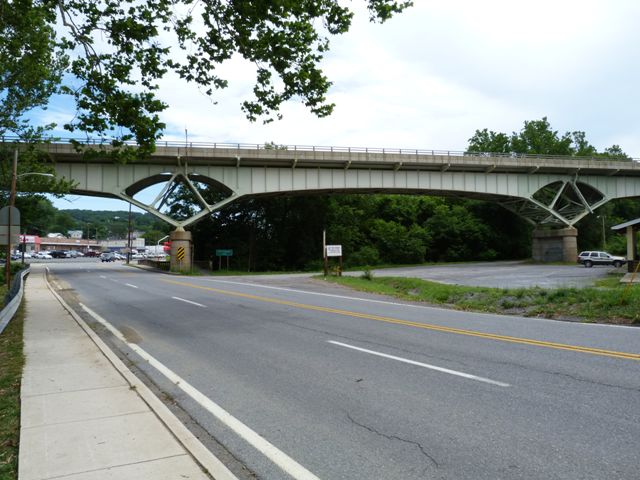We Recommend:
Bach Steel - Experts at historic truss bridge restoration.
BridgeHunter.com Phase 1 is released to the public! - Visit Now
US-522 Main Street Bridge

Primary Photographer(s): Nathan Holth and Rick McOmber
Bridge Documented: July 15, 2011
US-522 Over Little Tonoloway Creek, MD-144 (Main Street) and Limestone Road
Hancock: Washington County, Maryland: United States
1937 By Builder/Contractor: George B. Hazelwood of Cumberland, Maryland and Engineer/Design: Maryland State Roads Commission
1980
160.0 Feet (48.8 Meters)
586.0 Feet (178.6 Meters)
24 Feet (7.32 Meters)
4 Main Span(s)
100000210124010

View Information About HSR Ratings
Bridge Documentation
View Archived National Bridge Inventory Report - Has Additional Details and Evaluation
View The Historic Bridge Inventory Report For This Bridge
View Historical Articles About This Bridge
This bridge is both a rare example of a bridge using the Wichert truss design, which relates to the unusual detail over the piers. However, the overall structure type is a deck plate girder. As such, the bridge is a very rare example of a hybrid girder and truss bridge. South of this bridge a larger all-truss Wichert truss bridge is present.
Information and Findings From Maryland's Historic Bridge InventoryDiscussion of Wichert Trusses The Wichert Truss During the late nineteenth and early twentieth centuries, many variants of the Pratt and Warren truss designs were developed and put into service on United States roads and railroads. An additional significant twentieth century truss type which deserves mention is the Wichert truss, which was utilized in several important bridges built in Maryland. The Wichert truss is a significant type of continuous truss. Continuous trusses have a chord and web configuration that continues uninterrupted over one or more intermediate supports, compared with simply supported trusses which are supported only at each end. Due to concerns over potential stresses caused by intermediate pier settlement, continuous trusses were not generally employed until the early twentieth century. In 1930, E.M. Wichert of Pittsburgh addressed the problem with his Wichert truss, a continuous truss in which hinged quadrilateral sections were included over the intermediate piers. Wichert's first major truss bridge constructed to this design was the 1937 Homestead High Level Bridge over the Monongahela River at Pittsburgh. Maryland State Roads Commission engineers, noting the usefulness of the Wichert design for long river spans, built an early example of the Wichert truss between 1937 and 1939, in cooperation with the West Virginia State Roads Commission. A high-level crossing of the Potomac connecting Shepherdstown, West Virginia, with Washington County, Maryland, this extant 1,020-foot-long structure includes six spans of Wichert continuous deck trusses with a 24-foot clear roadway (Maryland State Roads Commission 1939a:80; Pennsylvania Historical and Museum Commission, and Pennsylvania Department of Transportation 1986:124). In 1939-1940, J.E. Greiner Company and the Maryland State Roads Commission incorporated Wichert-type deck trusses in the Governor Harry Nice Memorial Bridge over the Potomac and the Thomas Hatem Memorial Bridge crossing the Susquehanna at Havre de Grace (J.E. Greiner Company 1938). Continuous deck trusses were also utilized in portions of the first Chesapeake Bay Bridge, built between 1949 and 1952 by Greiner under state contract (Brown 1952:17). |
![]()
Photo Galleries and Videos: US-522 Main Street Bridge
Bridge Photo-Documentation
Original / Full Size PhotosA collection of overview and detail photos. This gallery offers photos in the highest available resolution and file size in a touch-friendly popup viewer.
Alternatively, Browse Without Using Viewer
![]()
Bridge Photo-Documentation
Mobile Optimized PhotosA collection of overview and detail photos. This gallery features data-friendly, fast-loading photos in a touch-friendly popup viewer.
Alternatively, Browse Without Using Viewer
![]()
Maps and Links: US-522 Main Street Bridge
Coordinates (Latitude, Longitude):
Search For Additional Bridge Listings:
Bridgehunter.com: View listed bridges within 0.5 miles (0.8 kilometers) of this bridge.
Bridgehunter.com: View listed bridges within 10 miles (16 kilometers) of this bridge.
Additional Maps:
Google Streetview (If Available)
GeoHack (Additional Links and Coordinates)
Apple Maps (Via DuckDuckGo Search)
Apple Maps (Apple devices only)
Android: Open Location In Your Map or GPS App
Flickr Gallery (Find Nearby Photos)
Wikimedia Commons (Find Nearby Photos)
Directions Via Sygic For Android
Directions Via Sygic For iOS and Android Dolphin Browser
USGS National Map (United States Only)
Historical USGS Topo Maps (United States Only)
Historic Aerials (United States Only)
CalTopo Maps (United States Only)

